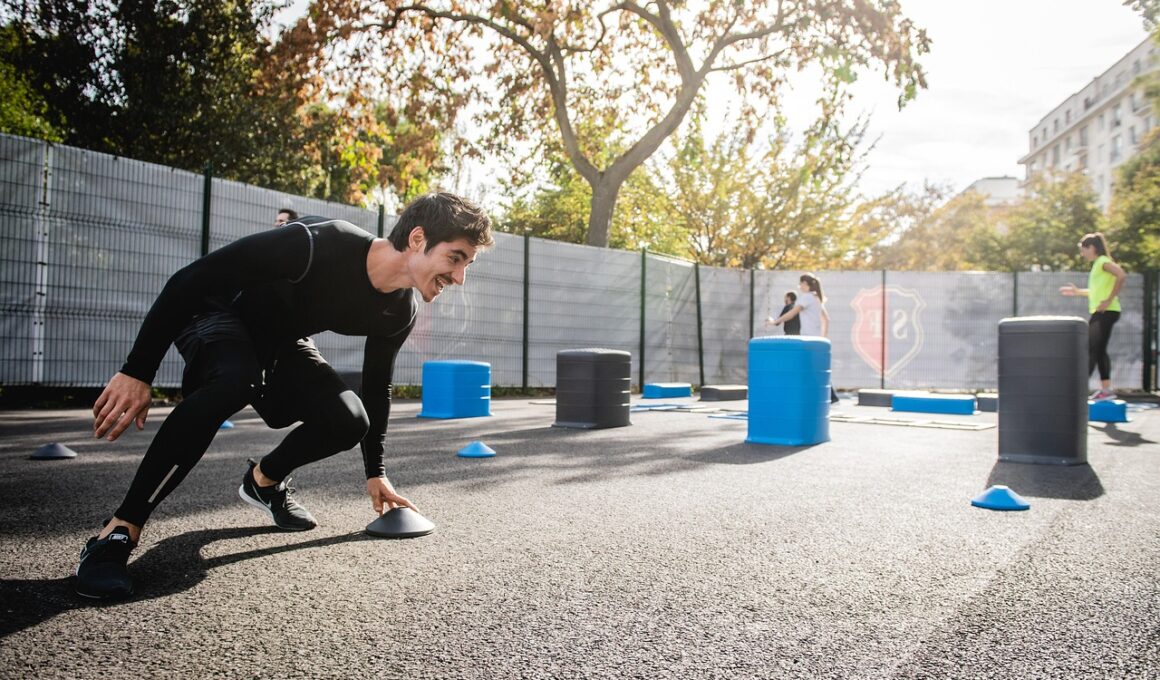CrossFit Workouts Designed for Endurance Athletes
CrossFit workouts are highly regarded for improving overall fitness, and they can be especially beneficial for endurance athletes. These workouts tend to combine elements of cardiovascular training, strength building, and flexibility exercises. By integrating multiple modalities, athletes can enhance their stamina and peak performance. Endurance athletes require a specific focus on their cardiovascular capacity and muscular endurance to excel. CrossFit workouts emphasize high-repetition movements and varied workout structures. Incorporating Olympic lifts, kettlebell swings, and functional movements can activate numerous muscle groups simultaneously, promoting improved endurance. Moreover, with the high-intensity aspect of CrossFit, athletes can focus on short bursts of effort followed by brief rest intervals. The varied nature of these workouts aids in preventing boredom, keeping athletes motivated while pushing their limits. Participation in group classes cultivates a sense of community. Athletes can encourage one another, share experiences, and cheer on their peers. This environment contributes to a positive and encouraging atmosphere that can enhance manual skills and perseverance needed in endurance sports.
CrossFit offers a unique array of workouts tailored specifically for endurance enhancement. One effective strategy is to target specific energy systems. Endurance athletes often rely on aerobic energy systems, but anaerobic conditioning can also be essential. CrossFit-style metcons (metabolic conditioning workouts) can be used effectively to develop both systems. Typical metcon workouts range from 10 to 20 minutes, combining aerobic and anaerobic exercise for an intense experience. Incorporating cycling, running, and rowing into metcons keeps the body engaged and adapting.
As athletes progress in their conditioning, workouts can be adjusted to focus on various energy systems, allowing for tailored adaptations. Additionally, interval training is particularly effective for endurance athletes, alternating between high-intensity efforts and recovery periods to improve cardiovascular fitness significantly. Integrating such interval workouts allows athletes to build strength while enhancing their endurance capabilities simultaneously. Consider adding weightlifting transitions after a cardiovascular effort in a metcon to challenge not only the heart but also the muscular system. Maintaining versatility in workout types prevents overuse injuries by encouraging a rounded training approach.
Understanding the principles behind CrossFit workouts allows endurance athletes to maximize their performance potential. Utilizing periodization is key in the workout design, ensuring that intensity, volume, and recovery cycles are balanced. Structured training blocks can aid in building strength and improving aerobic capacity without overtraining or injury. Incorporating variation by focusing on functional movements or agility drills can enrich the training experience. Coaches can also implement different training methods like circuit training, Tabata workouts, or EMOM (Every Minute On the Minute) sessions to maintain engagement.
Regularly changing workouts keeps athletes motivated and performing at their best. Moreover, continual adaptation and progress tracking are necessary to ensure workouts yield the desired results. Athletes should periodically assess their performance in different workouts to identify areas needing improvement. Together with smart adaptations in workouts, focusing on mobility, flexibility, and recovery, is essential for long-term success. Nutrition also plays a significant role in supporting the demands of CrossFit endurance training. Specific dietary strategies can enhance energy levels and recovery times, allowing endurance athletes to rise to challenges with better performance outcomes.
Essential Recovery Techniques
Recovery is as crucial as training itself for endurance athletes engaged in CrossFit workouts. Implementing recovery techniques enables athletes to rebuild their bodies and ensures longevity in their training. Active recovery methods, such as foam rolling, stretching, or yoga, maintain circulation and reduce muscle soreness post-workout. Proper nutrition and hydration also play major roles in the recovery process. Athletes should prioritize nutritious meals that support muscle repair and replenishment of glycogen stores.
In addition to nutritional strategies, adequate sleep is vital for recovery. Athletes must ensure they prioritize sleep and manage stress effectively to allow for optimal recovery. This multifaceted approach ensures that athletes are physically ready for subsequent training sessions while reducing the risk of injury. Recovery doesn’t solely involve passive actions; participating in lighter intensity workouts can aid recovery as well. CrossFit provides a comprehensive approach to enhance recovery with methodologies integrated into training plans. Athletes can also take advantage of passive recovery techniques such as massage therapy to help in muscle recovery and relaxation. Incorporating valuable recovery strategies strengthens endurance and promotes overall health.
A vital component of CrossFit workouts lies in setting measurable goals tailored to endurance athletes. Goal-setting helps athletes create a clear roadmap for their training and maintain motivation. A SMART (Specific, Measurable, Achievable, Relevant, Time-Bound) approach can significantly aid athletes in developing focused performance objectives. These objectives can cover various aspects of training, including strength levels, time trials, or specific workout formats. Tracking progress is important when pursuing these goals, and it allows athletes to adjust their training schedule accordingly if necessary.
Moreover, feedback from coaches or trainers can provide fresh insights into areas for improvement. Keeping a training journal detailing workouts can elucidate patterns and provide clarity. Besides performance goals, athletes may also benefit from ethical objectives focusing on character-building attributes. Endurance athletes may combine competition with camaraderie, motivating each other to reach their full potential. Effectively aligning personal expectations and aspirations fosters a supportive environment. This supportive community helps with mental resilience and team spirit, crucial for recovery and sustained effort throughout training cycles.
Nutritional Strategies for Endurance Athletes
Nourishing the body correctly is essential for endurance athletes participating in CrossFit workouts. Balanced nutrition can significantly affect performance levels, energy depletion, and recovery. Athletes should focus on macronutrients, ensuring a proper ratio of carbohydrates, proteins, and fats in their diet. Carbohydrates provide the necessary fuel for high-intensity workouts, while proteins support muscle growth and repair. Fats are vital for hormone production and overall energy management. Additionally, hydration should not be overlooked.
Each athlete must determine their fluid needs, especially during training sessions demanding high exertion levels. Consuming electrolytes can replenishes minerals lost in sweat and improve recovery times. Pre- and post-workout meals should be well-planned times for optimal recovery. Eating a combination of protein and carbs shortly after workouts aids efficiency in restoring muscle and energy levels. Meanwhile, athletes can benefit from experimenting with different nutritional strategies to find what works best for them. Listening to their bodies during nutrition adjustments will lead to greater insights and individualized nutrition plans tailored to their specific needs.
In conclusion, CrossFit workouts can drastically enhance the performance of endurance athletes when appropriately structured and executed. By integrating specific training methods, athletes can improve their aerobic capacity while building muscular endurance. Including recovery techniques is as essential as workout intensity to ensure athletes shine in their competitions. Furthermore, effective goal-setting, tracking progress, and adopting sound nutritional strategies contribute significantly to success. Integrating these concepts allows athletes to reach performance pinnacles and maximize their training experience.
By consistently evolving, these athletes can remain engaged in their workouts while achieving their long-term goals. CrossFit serves as an ideal framework for developing versatile athletes capable of excelling in various fields. Ultimately, the objective is to cultivate resilience and fortitude, allowing athletes to shoulder any challenge they may face. A supportive community plays an invaluable role in this journey. Endurance athletes are uniquely positioned to thrive in CrossFit environments, developing attributes that can lead to sustained success both in sports and everyday life.
In summary, CrossFit workouts present an excellent opportunity for endurance athletes to optimize their fitness. Combining strength, endurance, and metabolic conditioning facilitates internal improvements. With a dedication to their training, adept recovery practices, and informed nutrition, these athletes can achieve their aspirations. Success in this area demands commitment and consistent effort, but the rewards are undeniably satisfying. Athletes willing to embrace the CrossFit ethos can realize significant performance gains over time. By maintaining focus on these critical areas, they can unveil the full potential within their athleticism.


